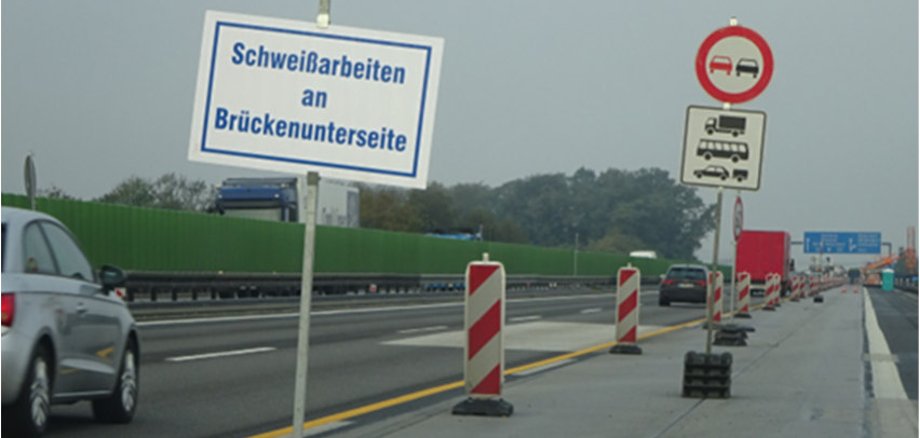It has given its all over the last few decades - the Mühlenfließ Bridge. Brandenburg's longest motorway bridge has defied the increasing traffic and the increased volume of heavy goods vehicles. Even though it was never built for this purpose. However, the tribute to the structure has not stopped there. An efficient and modern replacement is urgently needed. The bridge, resting on girders from the 1930s, is already only passable to a limited extent.
Multiple structural inspections and maintenance measures carried out with the aim of preserving the mighty structure clearly showed that only a new replacement would make sense for a permanent, safe and sustainable operation. "We took a close look at the structure," says Ronald Normann, Director of the North-East branch of Autobahn GmbH des Bundes, "and realised that only a new, modern and efficient bridge can guarantee safe operation in the future. This would certainly relieve the burden on the surrounding communities, the traffic restrictions could be lifted and noise protection could be significantly improved."
With the current bridge, which is already closed to heavy goods vehicles requiring a permit, there is a risk that other heavy goods traffic will also have to be kept off the bridge. "A scenario that we want to prevent at all costs. To this end, the old Mühlenfließbrücke will be repaired to such an extent that not all heavy goods traffic will be forced to pass through Rüdersdorf or the neighbouring communities. We are regularly working against the deterioration," says Director Normann.
Another advantage: the existing old Mühlenfließ Bridge could continue to be used for the planned modern and efficient new replacement construction, which could begin at the end of 2025. Ronald Normann: "This will prevent all the traffic from jamming through the streets of the neighbouring towns during the construction phase." Using a special construction method, the modern Mühlenfließ Bridge is to be completed within just three years. "We achieve this through external prefabrication of the individual components, which are delivered to the new bridge ready for use and inserted using a so-called incremental launching method. This not only creates speed, but also a considerable reduction in the indispensable construction site noise."
The new Mühlenfließ Bridge could be completed by the end of 2028 after a construction period of just three years. It will also be fitted with new girders, which would blend delicately into the existing landscape and give Brandenburg's longest bridge a modern and light appearance. "The bridge piers, which are almost 100 years old and are not listed, can no longer be used, even if this is desired. We have examined all the options here. Even with massive lateral pillar widening, these cannot be preserved and would always entail the risk of considerable damage to the new bridge, which in case of doubt would lead to a full closure. In short, a risk that cannot be taken," says Normann.
In return, the future Mühlenfließ Bridge could become considerably quieter. Not only the modern bridge bearings on the new bridge piers will contribute to this, but also a special carriageway surface. However, the greatest reduction in noise emissions for local residents would be realised by the possible noise barriers. "We are currently planning noise barriers that will be 5.50 metres high across almost the entire bridge. We are going as far as we can with a voluntary contribution from the federal government.
But the noise barriers also have two other special features: To match the slim and delicate design, they will be transparent. To further improve noise protection, they will also be inclined slightly outwards. Normann: "This deflects the noise emissions and reduces the sound energy."
Noise protection would be adapted to the significant increase in traffic figures in the future. For the year 2030, the calculations predict an average daily traffic volume of just under 75,000 vehicles. A significant increase compared to the 2021 calculations of around 49,000 vehicles. "In other words: a new, modern and efficient Mühlenfließ Bridge is urgently needed and very quickly. We have already developed appropriate design plans for this and have already presented them to the local political representatives responsible.
The next step is a broad-based public information event to which we will cordially invite all citizens of Rüdersdorf. The public information event will be held on 3 July 2024 in the "Martin Andersen Nexö" cultural centre in Rüdersdorf. The event will start at 5.30 pm.
"We will also be organising regular information events on the individual construction phases," says Ronald Normann. The roadmap for the future for a resilient and, above all, quieter Mühlenfließ Bridge has been finalised. What is even better is that the new replacement construction does not have to go through a planning approval procedure that could take years. This could lead to the entire lorry traffic being diverted through the surrounding villages at any time, especially in the case of the old bridge, which has been badly damaged. Normann:
"As this is a new replacement structure, we can quickly and easily build a new Mühlenfließ Bridge in accordance with the German Trunk Roads Act without the often complex planning approval procedure. Nevertheless, the support of local residents is extremely important to us and, of course, the active support of those with political responsibility. But I think we all want to move in the same direction here: fast new construction, less noise and a modern Mühlenfließ Bridge that is fit and safe for the future."
Ralph Brodel
Head of Communications
Press spokesman
Die Autobahn GmbH des Bundes
North-East Branch
An der A 111
16540 Hohen Neuendorf

